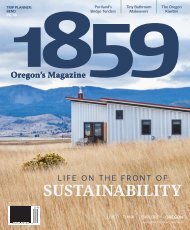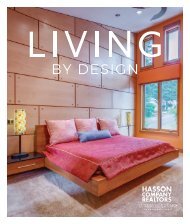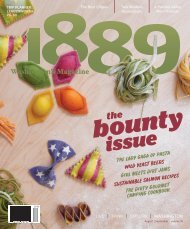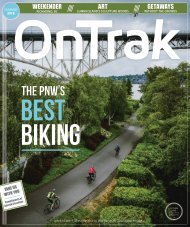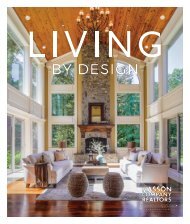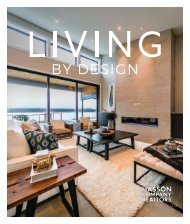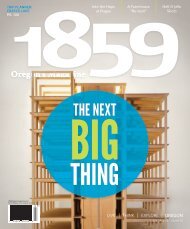You also want an ePaper? Increase the reach of your titles
YUMPU automatically turns print PDFs into web optimized ePapers that Google loves.
home + design<br />
Andrew Pogue<br />
FROM LEFT The model features a long exterior breezeway. Blonde bamboo floors and large windows welcome light into the space.<br />
construction versus a custom build. Prefab, short for prefabricated,<br />
applies to structures that are primarily manufactured in an off-site<br />
factory. Prefab was first made popular in the United States from<br />
1908 to 1940, when Sears, Roebuck and Co. sold 75,000 mail-order<br />
kit homes. While residential prefab building continued throughout<br />
the twentieth century, it regained in prominence when a plethora<br />
of modern architects returned to the form, as promoted in a 2003<br />
design contest sponsored by Dwell magazine. Staupe and Roy<br />
were searching for a prefab builder who clicked with their personal<br />
aesthetic, and found one in an unlikely place: the freeway. Roy was<br />
driving when he saw an intriguing module from Method Homes<br />
being transported on a trailer.<br />
Brian Abramson co-founded the Seattle-based Method Homes<br />
in 2008 and specializes in architect-designed, modular prefab<br />
construction. “Modular refers to large, volumetric modules that<br />
are mostly finished, then transported to the site,” Abramson said.<br />
Modern prefab homes like his can tackle two major problems<br />
in the construction industry—waste and energy efficiency. “By<br />
building off-site, we’re able to reduce the waste generated and<br />
reuse a lot of our scraps,” Abramson said. Additionally, if builders<br />
use newer technologies like structurally insulated panels, they can<br />
reduce a home’s carbon dioxide emissions and increase energy<br />
efficiency. “One of our core missions is sustainability, so even with<br />
our most baseline homes, we build well-above code,” Abramson<br />
said. His models come with a suite of environmentally friendly<br />
features, including low- or no-VOC paints and adhesives, no-UA<br />
formaldehyde in the building materials, FSC-certified hardwood<br />
floors, above-code insulation, energy efficient appliances and lowflow<br />
fixtures.<br />
After visiting Method’s factory in Ferndale, Staupe and Roy<br />
appreciated the company’s craftsmanship and green qualities, as<br />
well as the potential to customize their pick. During the design<br />
phase, they selected finishes, expanded and added windows, and<br />
tweaked the principle suite to fit a tub. Even better, once plans were<br />
finalized, construction was quick—just three months for fabrication<br />
in the factory, during which the foundation was poured on-site and<br />
the garage built. “Once they actually delivered the modules to the<br />
site, they had us in within just over two months,” Staupe said. “It was<br />
an incredibly fast process, and it felt even faster because we had a<br />
baby right towards the end!”<br />
The couple chose the Shift Model, designed by architect Ryan<br />
Stephenson of Stephenson Design Collective. For it, he stacked two<br />
modules, then “pushed them apart” to form a long, shaded exterior<br />
breezeway, which connects copious deck space and extends the<br />
interior living outdoors. The exterior was then faced with charcoal<br />
standing-seam metal and untreated cedar, which will patina to a<br />
silver-gray over time.<br />
At the entry, visitors are met with a stunning handcrafted<br />
bookcase, another customization requested by the couple. “It’s a real<br />
‘wow’ factor when you walk into the house,” Staupe said. Behind it,<br />
a staircase composed of floating concrete tread leads upstairs, while<br />
a nearby flex space can be used for an office or play area, depending<br />
on the family’s needs. Hallways on the perimeter of the first floor<br />
create easy circulation, flowing into an open kitchen, dining and<br />
living room. At the center, a necessary support beam is disguised<br />
with additional built-in shelves and a three-sided fireplace, which<br />
gently separates the rooms and provides a natural gathering spot.<br />
“I’m one of those people who would sit on top of a heater if I could,”<br />
Staupe said. “So I frequently sit right there.”<br />
During the design process, the couple “were really inspired by the<br />
Scandinavian aesthetic and what they do to welcome light into the<br />
house,” Staupe said. To that end, blonde bamboo floors meet crisp<br />
white walls, and kitchen cabinets in the same wood are wrapped<br />
with snowy quartz counters. Additionally, the enlarged windows<br />
bring in plenty of sunlight no matter the season. Thanks to the<br />
home’s more narrow footprint, the effect is that of being surrounded<br />
by the natural setting, which is just what the family wanted. “We<br />
bought our property because we loved the views,” Staupe said.<br />
Since moving into their home in 2013, Staupe and Roy have<br />
acclimated well to their new life, despite having been city dwellers<br />
for decades. “The house is such a welcome, comfortable place to<br />
come home to,” Staupe said. Moreover, their two young children<br />
are having a blast, whether they’re building mud kitchens, spinning<br />
in tree swings or racing scooters down dirt hills. “Between the<br />
property and the house itself,” Staupe said, “it’s kind of a dream for a<br />
child to grow up in.”<br />
28 <strong>1889</strong> WASHINGTON’S MAGAZINE FEBRUARY | MARCH <strong>2018</strong>





